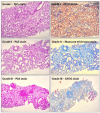Laboratory, Clinical, and Pathohistological Significance of the Outcomes of Patients with Membranous Nephropathy After 10 Year of Follow-Up
- PMID: 40868869
- PMCID: PMC12387156
- DOI: 10.3390/life15081221
Laboratory, Clinical, and Pathohistological Significance of the Outcomes of Patients with Membranous Nephropathy After 10 Year of Follow-Up
Abstract
Membranous nephropathy (MN) is the most prevalent cause of nephrotic syndrome (NS) in adults, and it can be primary (idiopathic) with an unknown cause or secondary due to a variety of conditions (lupus, infections, malignancies, medications, etc.). It progresses to chronic kidney disease (CKD) in up to 60% of patients, and 10 to 30% develop end-stage kidney disease (ESKD). This retrospective study examines the importance of specific factors, including baseline demographic and clinical data, kidney biopsy PH findings, and selected biochemical parameters, influencing MN outcomes after 10 years of follow-up. The cohort included 94 individuals in whom a diagnosis of MN was established by percutaneous biopsy of the left kidney's lower pole at the University Clinical Center of Serbia (UCCS) between 2008 and 2013. According to the outcomes, patients were divided into three groups: the recovery (Rec) group, with complete remission, including normal serum creatinine (Scr) and proteinuria (Prt), the group with development of chronic kidney disease (CKD), and the group with development of end-stage kidney disease (ESKD). Nephropathologists graded pathohistological (PH) results from I to III based on the observed PH findings. During the follow-up period, 33 patients were in the Rec group, CKD developed in 53 patients, and ESKD developed in 8 patients. Baseline creatinine clearance levels (Ccr), Scr, and uric acid (urate) were found to be significantly associated with the outcomes (p < 0.001). The lowest values of baseline Scr and urate were observed in the Rec group. The presence of acute kidney injury (AKI) or CKD at the time of kidney biopsy was associated with the more frequent development of ESKD (p = 0.02). Lower Ccr was associated with a higher likelihood of progressing to CKD (B = -0.021, p = 0.014), whereas older age independently predicted progression to ESKD (B = 0.02, p = 0.032). Based on this study, it was concluded that the most important biochemical and clinical factors that are associated with the outcomes of this disease are the values of Scr, Ccr, and urate and the existence of CKD at the time of kidney biopsy. Unlike most previous studies, the presence of HTN had no statistical significance in the outcome of the disease.
Keywords: chronic kidney disease; hypertension; membranous nephropathy; proteinuria.
Conflict of interest statement
The authors declare no conflicts of interest.
Figures



References
LinkOut - more resources
Full Text Sources
Miscellaneous

